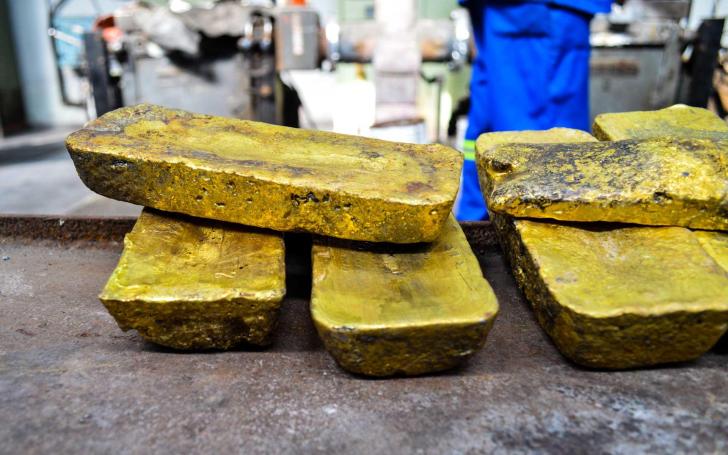News / National
Zimbabwe gold exports jump 25% in June
04 Jul 2025 at 08:22hrs |
0 Views

Zimbabwe's gold exports soared by 24 percent in the first five months of 2025, reaching US$748 million compared to US$599.2 million during the same period in 2024, according to figures released by the Reserve Bank of Zimbabwe (RBZ). The growth underscores the crucial role of the gold sector in powering the country's economy amid rising global bullion prices.
Monthly data from the RBZ highlights consistent performance in 2025: January exports stood at US$123.1 million (up from US$112 million), February recorded US$117 million (up from US$109 million), while March surged to US$155.6 million - almost doubling the US$82.2 million recorded the previous year. April's exports also saw a significant leap to US$183.3 million, up from US$102.6 million. However, May saw a slight dip to US$168.7 million, down from US$193.5 million in May 2024.
The year-on-year increase of US$148.8 million reflects sustained momentum in Zimbabwe's gold sector, the country's top foreign currency earner. In 2024, Zimbabwe exported gold worth US$1.52 billion, a figure likely to be surpassed in 2025 if current trends hold.
Small-scale miners remain the dominant force in the country's gold production. These secondary producers - often informal and operating with limited resources - have consistently outpaced large-scale primary producers in total gold deliveries to Fidelity Gold Refinery (FGR), the country's exclusive legal gold buyer.
Government initiatives to formalise and support artisanal and small-scale mining (ASM), along with improved organisational structures and incentivised official sales channels, have bolstered production. Additionally, sustained global price increases have made gold mining more lucrative, particularly for small-scale operations.
The current upturn in the sector coincides with a global rally in gold prices. In the first half of 2025, gold prices have surged by nearly 25 percent, driven by widespread policy uncertainty and intensifying geopolitical tensions. These dynamics have reinforced gold's appeal as a safe-haven asset, with central banks and investors ramping up their gold holdings.
The World Bank attributes the bullish trend to strong investor demand and central bank buying. The first quarter of 2025 saw the highest inflows into gold exchange-traded funds (ETFs) since 2022, while global central banks continue to increase their reserves.
Projections suggest that gold prices will rise by approximately 35 percent year-on-year in 2025 and remain significantly above historical averages into 2026. This price environment presents a substantial opportunity for Zimbabwe to capitalise on its gold reserves, particularly in terms of bolstering foreign currency inflows and stabilising the local economy.
Strategic investments in reopening closed mines and enhancing production at existing large-scale operations have further supported the sector's growth. Efforts to improve payment structures for small-scale miners have also contributed to formalised sales, strengthening the country's export capacity.
With global conditions still volatile, analysts warn that any escalation in geopolitical tensions could push gold prices even higher, providing Zimbabwe with an even greater windfall - if the country continues to effectively harness its production potential.
Monthly data from the RBZ highlights consistent performance in 2025: January exports stood at US$123.1 million (up from US$112 million), February recorded US$117 million (up from US$109 million), while March surged to US$155.6 million - almost doubling the US$82.2 million recorded the previous year. April's exports also saw a significant leap to US$183.3 million, up from US$102.6 million. However, May saw a slight dip to US$168.7 million, down from US$193.5 million in May 2024.
The year-on-year increase of US$148.8 million reflects sustained momentum in Zimbabwe's gold sector, the country's top foreign currency earner. In 2024, Zimbabwe exported gold worth US$1.52 billion, a figure likely to be surpassed in 2025 if current trends hold.
Small-scale miners remain the dominant force in the country's gold production. These secondary producers - often informal and operating with limited resources - have consistently outpaced large-scale primary producers in total gold deliveries to Fidelity Gold Refinery (FGR), the country's exclusive legal gold buyer.
Government initiatives to formalise and support artisanal and small-scale mining (ASM), along with improved organisational structures and incentivised official sales channels, have bolstered production. Additionally, sustained global price increases have made gold mining more lucrative, particularly for small-scale operations.
The current upturn in the sector coincides with a global rally in gold prices. In the first half of 2025, gold prices have surged by nearly 25 percent, driven by widespread policy uncertainty and intensifying geopolitical tensions. These dynamics have reinforced gold's appeal as a safe-haven asset, with central banks and investors ramping up their gold holdings.
The World Bank attributes the bullish trend to strong investor demand and central bank buying. The first quarter of 2025 saw the highest inflows into gold exchange-traded funds (ETFs) since 2022, while global central banks continue to increase their reserves.
Projections suggest that gold prices will rise by approximately 35 percent year-on-year in 2025 and remain significantly above historical averages into 2026. This price environment presents a substantial opportunity for Zimbabwe to capitalise on its gold reserves, particularly in terms of bolstering foreign currency inflows and stabilising the local economy.
Strategic investments in reopening closed mines and enhancing production at existing large-scale operations have further supported the sector's growth. Efforts to improve payment structures for small-scale miners have also contributed to formalised sales, strengthening the country's export capacity.
With global conditions still volatile, analysts warn that any escalation in geopolitical tensions could push gold prices even higher, providing Zimbabwe with an even greater windfall - if the country continues to effectively harness its production potential.
Source - the herald
Join the discussion
Loading comments…

















